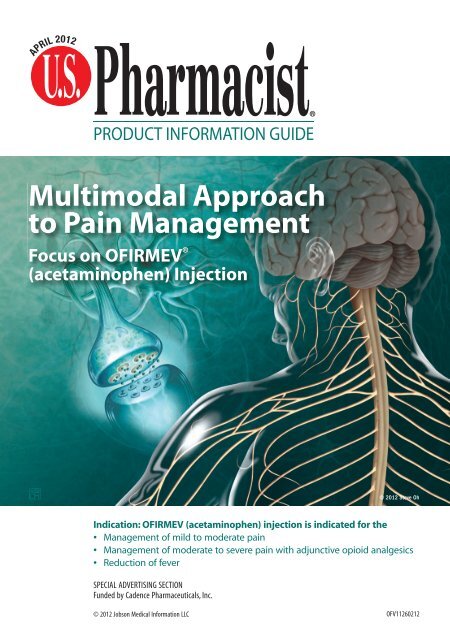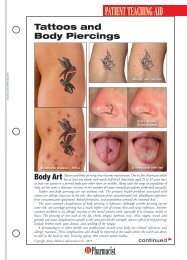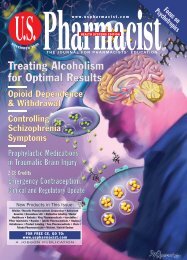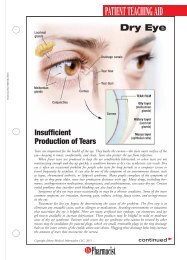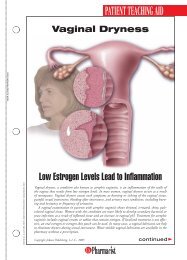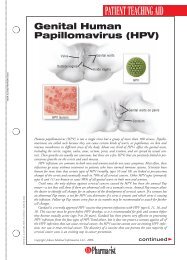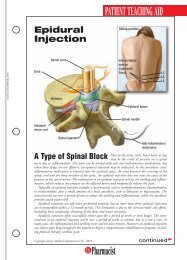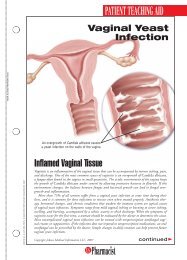Multimodal Approach to Pain Management Focus ... - U.S. Pharmacist
Multimodal Approach to Pain Management Focus ... - U.S. Pharmacist
Multimodal Approach to Pain Management Focus ... - U.S. Pharmacist
Create successful ePaper yourself
Turn your PDF publications into a flip-book with our unique Google optimized e-Paper software.
• If you do NOT receive your personal link from the Hosted Test server, please notifyme immediately. As stated above, you will only receive your personal Hosted Testlink at your Gmail address No other email address will be used <strong>to</strong> communicatewith you throughout the Academy year so check your Gmail address daily. Betteryet, set up Gmail <strong>to</strong> au<strong>to</strong>matically forward <strong>to</strong> your standard email address. That wayyou can be assured you won't miss anything.• We will insure that you do not fail by allowing you <strong>to</strong> retake the exam until you reachthe minimum 70% score. If you do not pass on the first try, you will be providedwith specific references <strong>to</strong> help you obtain the correct answer before retaking the test.(In the past eight years since using Hosted Test, only 1 student out of six districtsparticipating in the DLA did not pass on the first try and that was only for one test.)o Disagreement With Test Answer: For each test, the questions will be grouped by specificreferences. First the Reference / Source will be listed and then, all of the questions related <strong>to</strong>that reference will follow. The entire test will be formatted in this matter for each and everycourse-. If you use any other source than the one listed for the specific question and youcome up with a different answer, you will not be given credit for the question. Use ONLYthe reference / source listed for the specific group of questions in order <strong>to</strong> obtain the correctanswer. If, upon completing the final exam and receiving your score, you feel that aparticular answer is incorrect, please notify me. I shall review your challenge and respond.If your challenge stands, your score will be adjusted as will all of the scores of your fellowstudents. If it does not stand, no change will be made <strong>to</strong> your score... (Note: for the 2011-2012 Academy year, since redesigning the test format, there were no challenges <strong>to</strong> any of thequestions.)• Ninth: You may not move forward <strong>to</strong> the next course until you have completed and passed theFinal Exam for all previous courses. This is moni<strong>to</strong>red by the Dean, the instruc<strong>to</strong>rs and thewebmaster.• Ten: For the 2011-2012 Academy year you will be doing extensive work on the LeadershipAcademy Google Group. You will be using the group in the following ways:o 1. To respond <strong>to</strong> required discussion <strong>to</strong>pics posted by all of your instruc<strong>to</strong>rs. Responding <strong>to</strong>these <strong>to</strong>pics is part of your course “assignment” and your participation will be scored by eachinstruc<strong>to</strong>r.o 2. To resolve any problems or questions you may have. When you have a question or yourun in<strong>to</strong> a problem, we want you <strong>to</strong> go <strong>to</strong> the Google Group first and use the GG <strong>to</strong> workwith your fellow students and notify your instruc<strong>to</strong>rs if you are having a problem or aquestion.o 3. To collaborate on your DLA assignments. We encourage you <strong>to</strong> work <strong>to</strong>gether with yourclassmates on your assignments, especially when you are developing strategic plans,membership plans, PR plans, etc. If there are several of you in the same club or the samecommunity, get <strong>to</strong>gether and work on your assignments. You do not have <strong>to</strong> work alone.You will find the DLA work much easier if you work with your classmates andcommunicate with your instruc<strong>to</strong>rs when questions or problems arise. Don't waste "hours"looking for something!!! CONTACT YOUR INSTRUCTOR and/or the WEBMASTER.5
HIGHLIGHTS OF PRESCRIBING INFORMATIONThese highlights do not include all the informationneeded <strong>to</strong> use OFIRMEV ® safely and effectively. Seefull prescribing information for OFIRMEV.OFIRMEV (acetaminophen) InjectionInitial U.S. Approval: 1951INDICATIONS AND USAGEOFIRMEV (acetaminophen) injection is indicated for the• <strong>Management</strong> of mild <strong>to</strong> moderate pain (1)• <strong>Management</strong> of moderate <strong>to</strong> severe pain withadjunctive opioid analgesics (1)• Reduction of fever (1)DOSAGE AND ADMINISTRATION• OFIRMEV may be given as a single or repeateddose. (2.1)• OFIRMEV should be administered only as a15-minute intravenous infusion. (2.4)Adults and Adolescents Weighing 50 kg and Over:• 1000 mg every 6 hours or 650 mg every 4 hours <strong>to</strong>a maximum of 4000 mg per day. Minimum dosinginterval of 4 hours. (2.2)Adults and Adolescents Weighing Under 50 kg:• 15 mg/kg every 6 hours or 12.5 mg/kg every 4 hours<strong>to</strong> a maximum of 75 mg/kg per day. Minimumdosing interval of 4 hours. (2.2)Children:• Children ≥ 2 <strong>to</strong> 12 years old: 15 mg/kg every 6hours or 12.5 mg/kg every 4 hours <strong>to</strong> a maximumof 75 mg/kg per day. Minimum dosing interval of4 hours. (2.3)DOSAGE FORMS AND STRENGTHS• Injection for intravenous infusion.• Each 100 mL glass vial contains 1000 mgacetaminophen (10 mg/mL). (3)CONTRAINDICATIONSAcetaminophen is contraindicated:• In patients with known hypersensitivity <strong>to</strong>acetaminophen or <strong>to</strong> any of the excipients in the IVformulation. (4)• In patients with severe hepatic impairment or severeactive liver disease. (4)WARNINGS AND PRECAUTIONS• Administration of acetaminophen in doses higherthan recommended may result in hepatic injury,including the risk of severe hepa<strong>to</strong><strong>to</strong>xicity anddeath. (5.1)• Do not exceed the maximum recommended dailydose of acetaminophen. (5.1)FULL PRESCRIBING INFORMATION: CONTENTS*1. INDICATIONS AND USAGE2. DOSAGE AND ADMINISTRATION2.1 General Dosing Information2.2 Recommended Dosage: Adults andAdolescents2.3 Recommended Dosage: Children2.4 Instructions for Intravenous Administration3. DOSAGE FORMS AND STRENGTHS4. CONTRAINDICATIONS5. WARNINGS AND PRECAUTIONS5.1 Hepatic Injury5.2 Allergy and Hypersensitivity6. ADVERSE REACTIONS6.1 Clinical Trial Experience7. DRUG INTERACTIONS7.1 Effects of other Substances on Acetaminophen7.2 Anticoagulants8. USE IN SPECIFIC POPULATIONS8.1 Pregnancy8.2 Labor and Delivery• Use caution when administering acetaminophenin patients with the following conditions: hepaticimpairment or active hepatic disease, in casesof alcoholism, chronic malnutrition, severehypovolemia, or severe renal impairment (creatinineclearance ≤ 30 mL/min). (5.1)• Discontinue OFIRMEV immediately if symp<strong>to</strong>msassociated with allergy or hypersensitivity occur.Do not use in patients with acetaminophen allergy.(5.2)ADVERSE REACTIONSThe most common adverse reactions in patients treatedwith OFIRMEV were nausea, vomiting, headache,and insomnia in adult patients and nausea, vomiting,constipation, pruritus, agitation, and atelectasis in pediatricpatients. (6.1)To report SUSPECTED ADVERSE REACTIONS,contact Cadence Pharmaceuticals Inc. at 1-877-647-2239 or FDA at 1-800-FDA-1088 or www.fda.gov/medwatch.DRUG INTERACTIONS• Substances that induce or regulate hepaticcy<strong>to</strong>chrome enzyme CYP2E1 may alter themetabolism of acetaminophen and increase itshepa<strong>to</strong><strong>to</strong>xic potential. (7.1)• Chronic oral acetaminophen use at a dose of 4000mg/day has been shown <strong>to</strong> cause an increase ininternational normalized ratio (INR) in some patientswho have been stabilized on sodium warfarin as ananticoagulant. (7.2)USE IN SPECIFIC POPULATIONS• Pregnancy: Category C. There are no studies ofintravenous acetaminophen in pregnant women.Use only if clearly needed. (8.1)• Nursing Mothers: Caution should be exercisedwhen administered <strong>to</strong> a nursing woman. (8.3)• Pediatric Use: The effectiveness of OFIRMEV forthe treatment of acute pain and fever has not beenstudied in pediatric patients less than 2 years ofage. The safety and effectiveness of OFIRMEV inpediatric patients older than 2 years is supported byevidence from adequate and well controlled studiesin adults with additional safety and pharmacokineticdata for this age group. (8.4)• Geriatric Use: No overall differences in safety oreffectiveness were observed between geriatric andyounger subjects. (8.5)• Hepatic Impairment: OFIRMEV is contraindicatedin patients with severe hepatic impairment or severeactive liver disease and should be used with cautionin patients with hepatic impairment or active liverdisease. (4, 5.1, 8.6)• Renal Impairment: In cases of severe renalimpairment, longer dosing intervals and a reduced<strong>to</strong>tal daily dose of acetaminophen may bewarranted. (5.1, 8.7)Revised: 11/20108.3 Nursing Mothers8.4 Pediatric Use8.5 Geriatric Use8.6 Patients with Hepatic Impairment8.7 Patients with Renal Impairment10. OVERDOSAGE11. DESCRIPTION12. CLINICAL PHARMACOLOGY12.1 Mechanism of Action12.2 Pharmacodynamics12.3 Pharmacokinetics13. NONCLINICAL TOXICOLOGY13.1 Carcinogenesis, Mutagenesis, Impairment ofFertility14. CLINICAL STUDIES14.1 Adult Acute <strong>Pain</strong>14.2 Adult Fever14.3 Pediatric Acute <strong>Pain</strong> and Fever16. HOW SUPPLIED/STORAGE AND HANDLING*Sections or subsections omitted from the full prescribinginformation are not listed.FULL PRESCRIBING INFORMATION1 INDICATIONS AND USAGEOFIRMEV ® (acetaminophen) injection is indicated for• the management of mild <strong>to</strong> moderate pain• the management of moderate <strong>to</strong> severe pain withadjunctive opioid analgesics• the reduction of fever.2 DOSAGE AND ADMINISTRATION2.1 General Dosing InformationOFIRMEV may be given as a single orrepeated dose for the treatment of acute pain or fever.No dose adjustment is required when convertingbetween oral acetaminophen and OFIRMEV dosingin adults and adolescents. The maximum daily dose ofacetaminophen is based on all routes of administration(i.e. intravenous, oral, and rectal) and all productscontaining acetaminophen.2.2 Recommended Dosage: Adults and AdolescentsAdults and adolescents weighing 50 kg andover: the recommended dosage of OFIRMEV is 1000mg every 6 hours or 650 mg every 4 hours, with amaximum single dose of OFIRMEV of 1000 mg, aminimum dosing interval of 4 hours, and a maximumdaily dose of acetaminophen of 4000 mg per day.Adults and adolescents weighing under50 kg: the recommended dosage of OFIRMEV is15 mg/kg every 6 hours or 12.5 mg/kg every 4 hours,with a maximum single dose of OFIRMEV of 15 mg/kg,a minimum dosing interval of 4 hours, and a maximumdaily dose of acetaminophen of 75 mg/kg per day.Table 1: Dosing for Adults and AdolescentsAge group Dose given Dose given Maximum Maximum <strong>to</strong>talevery 4hoursevery 6 hours single dose daily dose ofacetaminophen(by any routes)Adults andadolescents(13 years andolder) weighing≥ 50 kgAdults andadolescents(13 years andolder) weighing< 50 kg650 mg 1000 mg 1000 mg 4000 mg in24 hours12.5 mg/kg 15 mg/kg 15 mg/kg 75 mg/kg in24 hours(up <strong>to</strong> 750 mg)(up <strong>to</strong> 3750 mg)2.3 Recommended Dosage: ChildrenChildren ≥ 2 <strong>to</strong> 12 years of age: therecommended dosage of OFIRMEV is 15 mg/kgevery 6 hours or 12.5 mg/kg every 4 hours, with amaximum single dose of OFIRMEV of 15 mg/kg, aminimum dosing interval of 4 hours, and a maximumdaily dose of acetaminophen of 75 mg/kg per day.2.4 Instructions for Intravenous AdministrationFor adult and adolescent patientsweighing ≥ 50 kg requiring 1000 mg doses ofOFIRMEV, administer the dose by inserting avented intravenous set through the septum of the100 mL vial. OFIRMEV may be administered withoutfurther dilution. Examine the vial contents before dosepreparation or administering. DO NOT USE if particulatematter or discoloration is observed. Administer thecontents of the vial intravenously over 15-minutes.Use aseptic technique when preparing OFIRMEV forintravenous infusion. Do not add other medications <strong>to</strong>the OFIRMEV vial or infusion device.For doses less than 1000 mg, the appropriatedose must be withdrawn from the vial and placed in<strong>to</strong>a separate container prior <strong>to</strong> administration. Usingaseptic technique, withdraw the appropriate dose (650mg or weight-based) from an intact sealed OFIRMEVvial and place the measured dose in a separate empty,sterile container (e.g. glass bottle, plastic intravenouscontainer, or syringe) for intravenous infusion <strong>to</strong> avoidthe inadvertent delivery and administration of the <strong>to</strong>talvolume of the commercially available container. Theentire 100 mL vial of OFIRMEV is not intended for use
ody surface area comparison.In a continuous breeding study, pregnant micereceived 0.25, 0.5, or 1.0% acetaminophen via thediet (357, 715, or 1430 mg/kg/day). These doses areapproximately 0.43, 0.87, and 1.7 times the MHDD,respectively, based on a body surface area comparison.A dose-related reduction in body weights of fourth andfifth litter offspring of the treated mating pair occurredduring lactation and post-weaning at all doses. Animalsin the high dose group had a reduced number of litters permating pair, male offspring with an increased percentageof abnormal sperm, and reduced birth weights in the nextgeneration pups.8.2 Labor and DeliveryThere are no adequate and well-controlled studieswith OFIRMEV during labor and delivery; therefore,it should be used in such settings only after a carefulbenefit-risk assessment.8.3 Nursing MothersWhile studies with OFIRMEV have not beenconducted, acetaminophen is secreted in human milk insmall quantities after oral administration. Based on datafrom more than 15 nursing mothers, the calculated infantdaily dose of acetaminophen is approximately 1 – 2% ofthe maternal dose. There is one well-documented repor<strong>to</strong>f a rash in a breast-fed infant that resolved when themother s<strong>to</strong>pped acetaminophen use and recurred whenshe resumed acetaminophen use. Caution should beexercised when OFIRMEV is administered <strong>to</strong> a nursingwoman.8.4 Pediatric UseThe safety and effectiveness of OFIRMEV for thetreatment of acute pain and fever in pediatric patientsages 2 years and older is supported by evidence fromadequate and well-controlled studies of OFIRMEVin adults. Additional safety and pharmacokinetic datawere collected in 355 patients across the full pediatricage strata, from premature neonates (≥ 32 weeks postmenstrual age) <strong>to</strong> adolescents. The effectiveness ofOFIRMEV for the treatment of acute pain and fever hasnot been studied in pediatric patients < 2 years of age.[see DOSAGE AND ADMINISTRATION - RecommendedDosage: Children (2.3) and PHARMACOKINETICS(12.3)].8.5 Geriatric UseOf the <strong>to</strong>tal number of subjects in clinical studiesof OFIRMEV, 15% were age 65 and over, while 5%percent were age 75 and over. No overall differencesin safety or effectiveness were observed between thesesubjects and younger subjects, and other reported clinicalexperience has not identified differences in responsesbetween the elderly and younger patients, but greatersensitivity of some older individuals cannot be ruled out.8.6 Patients with Hepatic ImpairmentAcetaminophen is contraindicated in patients withsevere hepatic impairment or severe active liver diseaseand should be used with caution in patients with hepaticimpairment or active liver disease [see WARNINGS ANDPRECAUTIONS (5.1), CLINICAL PHARMACOLOGY(12)]. A reduced <strong>to</strong>tal daily dose of acetaminophen maybe warranted.8.7 Patients with Renal ImpairmentIn cases of severe renal impairment (creatinineclearance ≤ 30 mL/min), longer dosing intervals anda reduced <strong>to</strong>tal daily dose of acetaminophen may bewarranted.10 OVERDOSAGESigns and Symp<strong>to</strong>msIn acute acetaminophen overdosage, dosedependent,potentially fatal hepatic necrosis is themost serious adverse effect. Renal tubular necrosis,hypoglycemic coma, and thrombocy<strong>to</strong>penia may alsooccur. Plasma acetaminophen levels > 300 mcg/mLat 4 hours after oral ingestion were associated withhepatic damage in 90% of patients; minimal hepaticdamage is anticipated if plasma levels at 4 hours are< 150 mcg/mL or < 37.5 mcg/mL at 12 hours afteringestion. Early symp<strong>to</strong>ms following a potentiallyhepa<strong>to</strong><strong>to</strong>xic overdose may include: nausea, vomiting,diaphoresis, and general malaise. Clinical and labora<strong>to</strong>ryevidence of hepatic <strong>to</strong>xicity may not be apparent until 48<strong>to</strong> 72 hours post-ingestion.TreatmentIf an acetaminophen overdose is suspected, obtaina serum acetaminophen assay as soon as possible, but nosooner than 4 hours following oral ingestion. Obtain liverfunction studies initially and repeat at 24-hour intervals.Administer the antidote N-acetylcysteine (NAC) as earlyas possible. As a guide <strong>to</strong> treatment of acute ingestion,the acetaminophen level can be plotted against time sinceoral ingestion on a nomogram (Rumack-Matthew). Thelower <strong>to</strong>xic line on the nomogram is equivalent <strong>to</strong> 150mcg/mL at 4 hours and 37.5 mcg/mL at 12 hours. Ifserum level is above the lower line, administer the entirecourse of NAC treatment. Withhold NAC therapy if theacetaminophen level is below the lower line.For additional information, call a poison control centerat 1-800-222-1222.11 DESCRIPTIONAcetaminophen is a non-salicylate antipyreticand non-opioid analgesic agent. Its chemical nameis N-acetyl-p-aminophenol. Acetaminophen has amolecular weight of 151.16. Its structural formula is:OFIRMEV injection is a sterile, clear, colorless,non pyrogenic, iso<strong>to</strong>nic formulation of acetaminophenintended for intravenous infusion. It has a pH ofapproximately 5.5 and an osmolality of approximately290 mOsm/kg. Each 100 mL contains 1000 mgacetaminophen, USP, 3850 mg manni<strong>to</strong>l, USP, 25 mgcysteine hydrochloride, monohydrate, USP, 10.4 mgdibasic sodium phosphate, USP. pH is adjusted withhydrochloric acid and/or sodium hydroxide.12 CLINICAL PHARMACOLOGY12.1 Mechanism of ActionThe precise mechanism of the analgesic andantipyretic properties of acetaminophen is not establishedbut is thought <strong>to</strong> primarily involve central actions.12.2 PharmacodynamicsAcetaminophen has been shown <strong>to</strong> have analgesicand antipyretic activities in animal and human studies.Single doses of OFIRMEV up <strong>to</strong>3000 mg and repeated doses of 1000 mg every 6 hoursfor 48 hours have not been shown <strong>to</strong> cause a significanteffect on platelet aggregation. Acetaminophen does nothave any immediate or delayed effects on small-vesselhemostasis. Clinical studies of both healthy subjects andpatients with hemophilia showed no significant changesin bleeding time after receiving multiple doses of oralacetaminophen.12.3 PharmacokineticsDistributionThe pharmacokinetics of OFIRMEV have beenstudied in patients and healthy subjects from prematureneonates up <strong>to</strong> adults 60 years old. The pharmacokineticprofile of OFIRMEV has been demonstrated <strong>to</strong> be doseproportional in adults following administration of singledoses of 500, 650, and 1000 mg.The maximum concentration (Cmax) occurs at theend of the 15 minute intravenous infusion of OFIRMEV.Compared <strong>to</strong> the same dose of oral acetaminophen,the Cmax following administration of OFIRMEV is up<strong>to</strong> 70% higher, while overall exposure (area under theconcentration time curve [AUC]) is very similar.Pharmacokinetic parameters of OFIRMEV (AUC,Cmax, terminal elimination half-life [T ½], systemic clearance[CL], and volume of distribution at steady state [Vss])following administration of a single intravenous dose of15 mg/kg for the pediatric population and1000 mg in adults are summarized in Table 3.Table 3: OFIRMEV Pharmacokinetic ParametersSubpopulationsNeonatesInfantsChildrenAdolescentsAdultsAUC(µg ×h/mL)62(11)57(54)38(8)41(7)43(11)Cmax(µg/mL)25(4)29(24)29(7)31(9)28(21)Mean (SD)T½(h)7.0(2.7)4.2(2.9)3.0(1.5)2.9(0.7)2.4(0.6)CL(L/h/kg)0.12(0.04)0.29(0.15)0.34(0.10)0.29(0.08)0.27(0.08)Vss(L/kg)1.1(0.2)1.1(0.3)1.2(0.3)1.1(0.3)0.8(0.2)The pharmacokinetic exposure of OFIRMEVobserved in children and adolescents is similar <strong>to</strong> adults,but higher in neonates and infants. Dosing simulationsfrom pharmacokinetic data in infants and neonatessuggest that dose reductions of 33% in infants 1 month<strong>to</strong> < 2 years of age, and 50% in neonates up <strong>to</strong> 28 days,with a minimum dosing interval of 6 hours, will producea pharmacokinetic exposure similar <strong>to</strong> that observed inchildren age 2 years and older.At therapeutic levels, binding of acetaminophen<strong>to</strong> plasma proteins is low (ranging from 10% <strong>to</strong> 25%).Acetaminophen appears <strong>to</strong> be widely distributedthroughout most body tissues except fat.Metabolism and ExcretionAcetaminophen is primarily metabolized in theliver by first-order kinetics and involves three principalseparate pathways: Conjugation with glucuronide,conjugation with sulfate, and oxidation via thecy<strong>to</strong>chrome P450 enzyme pathway, primarily CYP2E1,<strong>to</strong> form a reactive intermediate metabolite (N-acetyl-pbenzoquinoneimine or NAPQI). With therapeutic doses,NAPQI undergoes rapid conjugation with glutathioneand is then further metabolized <strong>to</strong> form cysteine andmercapturic acid conjugates.Acetaminophen metabolites are mainly excretedin the urine. Less than 5% is excreted in the urine asunconjugated (free) acetaminophen and more than 90%of the administered dose is excreted within 24 hours.13 NONCLINICAL TOXICOLOGY13.1 Carcinogenesis, Mutagenesis, Impairment ofFertilityCarcinogenesisLong-term studies in mice and rats have beencompleted by the National Toxicology Program <strong>to</strong>evaluate the carcinogenic potential of acetaminophen.In 2-year feeding studies, F344/N rats and B6C3F1mice were fed a diet containing acetaminophen up<strong>to</strong> 6000 ppm. Female rats demonstrated equivocalevidence of carcinogenic activity based on increasedincidences of mononuclear cell leukemia at 0.8times the maximum human daily dose (MHDD) of4 grams/day, based on a body surface area comparison.In contrast, there was no evidence of carcinogenicactivity in male rats (0.7 times) or mice (1.2-1.4 timesthe MHDD, based on a body surface area comparison).Mutagenesis
Acetaminophen was not mutagenic in the bacterialreverse mutation assay (Ames test). In contrast,acetaminophen tested positive in the in vitro mouselymphoma assay and the in vitro chromosomal aberrationassay using human lymphocytes. In the publishedliterature, acetaminophen has been reported <strong>to</strong> beclas<strong>to</strong>genic when administered a dose of 1500 mg/kg/day<strong>to</strong> the rat model (3.6-times the MHDD, based ona body surface area comparison). In contrast,no clas<strong>to</strong>genicity was noted at a dose of750 mg/kg/day (1.8-times the MHDD, based on a bodysurface area comparison), suggesting a threshold effect.Impairment of fertilityIn studies conducted by the National ToxicologyProgram, fertility assessments have been completed inSwiss mice via a continuous breeding study. There wereno effects on fertility parameters in mice consuming up <strong>to</strong>1.7 times the MHDD of acetaminophen, based on a bodysurface area comparison. Although there was no effect onsperm motility or sperm density in the epididymis, therewas a significant increase in the percentage of abnormalsperm in mice consuming 1.7 times the MHDD (basedon a body surface area comparison) and there was areduction in the number of mating pairs producing a fifthlitter at this dose, suggesting the potential for cumulative<strong>to</strong>xicity with chronic administration of acetaminophennear the upper limit of daily dosing.Published studies in rodents report that oralacetaminophen treatment of male animals at doses thatare 1.2 times the MHDD and greater (based on a bodysurface area comparison) result in decreased testicularweights, reduced sperma<strong>to</strong>genesis, reduced fertility, andreduced implantation sites in females given the samedoses. These effects appear <strong>to</strong> increase with the durationof treatment. The clinical significance of these findingsis not known.14 CLINICAL STUDIES14.1 Adult Acute <strong>Pain</strong>The efficacy of OFIRMEV in the treatment ofacute pain in adults was evaluated in two randomized,double-blind, placebo-controlled clinical trials in patientswith pos<strong>to</strong>perative pain.<strong>Pain</strong> Study 1 evaluated the analgesic efficacy ofrepeated doses of OFIRMEV l000 mg vs. placebo every6 hours for 24 hours in 101 patients with moderate <strong>to</strong>severe pain following <strong>to</strong>tal hip or knee replacement.OFIRMEV was statistically superior <strong>to</strong> placebo forreduction in pain intensity over 24 hours. There was anattendant decrease in opioid consumption, the clinicalbenefit of which was not demonstrated.<strong>Pain</strong> Study 2 evaluated the analgesicefficacy of repeated doses of OFIRMEV1000 mg every 6 hours or 650 mg every 4 hours for 24hours versus placebo in the treatment of 244 patientswith moderate <strong>to</strong> severe pos<strong>to</strong>perative pain afterabdominal laparoscopic surgery. Patients receivingOFIRMEV experienced a statistically significantgreater reduction in pain intensity over 24 hourscompared <strong>to</strong> placebo.14.2 Adult FeverThe efficacy of OFIRMEV 1000 mg in thetreatment of adult fever was evaluated in onerandomized, double-blind, placebo-controlled clinicaltrial. The study was a 6-hour, single-dose, endo<strong>to</strong>xininducedfever study in 60 healthy adult males. Astatistically significant antipyretic effect of OFIRMEVwas demonstrated through 6 hours in comparison <strong>to</strong>placebo. The mean temperature over time is shown inFigure 1.Mean Temperature (°C)40.039.539.038.538.00 1 2 3 4 5 6Time Post Dose (Hours)Figure 1: Mean Temperature (°C) Over Time14.3 Pediatric Acute <strong>Pain</strong> and FeverIV acetaminophenPlaceboOFIRMEV was studied in 355 pediatric patientsin two active-controlled and three open-label safety andpharmacokinetic trials [see PEDIATRIC USE (8.4)].16 HOW SUPPLIED/STORAGE AND HANDLINGOFIRMEV is supplied in a 100 mL glass vialcontaining 1000 mg acetaminophen (10 mg/mL).Car<strong>to</strong>n of 24 vials, NDC 43825-102-01OFIRMEV should be s<strong>to</strong>red at 20 °C <strong>to</strong>25 °C (68 °F <strong>to</strong> 77 °F) [See USP Controlled RoomTemperature].For single use only. The product should be used within 6hours after opening. Do not refrigerate or freeze.OFIRMEV (acetaminophen) injectionManufactured for:Cadence Pharmaceuticals, Inc.San Diego, CA 92130Revised 11/2010© 2010 Cadence Pharmaceuticals, Inc. All rightsreserved.OFIRMEV and CADENCE ® are trademarks of CadencePharmaceuticals, Inc.U.S. PATENT NUMBERS: 6,028,222; 6,992,218


